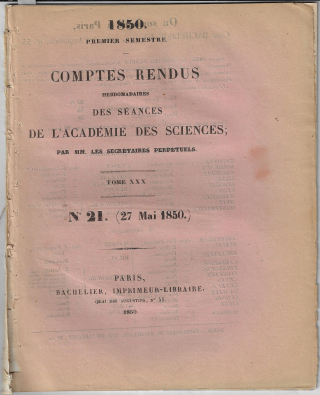 Blanquart-Evrard, "Photographie sur papier. Moyen d'obtenir l'image a la chambre noire sur paper sec, pp 663-665. Offered in the weekly issue of the "Comptes Rendus" for 27 May 1850, pp 647-652 in the issue of pp 637-672. Offered with the original front wrapper, detached.
Blanquart-Evrard, "Photographie sur papier. Moyen d'obtenir l'image a la chambre noire sur paper sec, pp 663-665. Offered in the weekly issue of the "Comptes Rendus" for 27 May 1850, pp 647-652 in the issue of pp 637-672. Offered with the original front wrapper, detached.
Helmut Gernsheim (History of Photography) notes that this publication by Blancquart-Evrard (along with his 1851 paper "Photographie sur papier" in 1851 "marked the beginning of a new era of photography" by introducing a "very considerable improvement of Talbot's calotype process". The calotype process offered very contrasty images and were lacking in half-tone sensibilities; "the paper ("wet process") approach by Blancquart-Evrard, which provided a (paper) surface impregnated with silver nitrate (and therefore much more light-sensitive), was much more able to reveal tone and detail.”
Also offered, another highly significant paper in the history of photography:
Alphonse Louis Poitevin, "Photographie sur gelatine, moyen d'obtenir des spreuves negatives tres-nettes et tres-transparentes, pouvant etre reportees, un grand nombre de fois sur le papier photographique ordinaire." [Title translated roughly as ""Photograph on gelatine, a means of obtaining very transparent and very transparent negatives, which can be carried over a great number of times on ordinary photographic paper."] Offered in the weekly issue of the "Comptes Rendus" for 27 May 1850, pp 647-652 in the issue of pp 637-672. Offered with the original front wrapper, detached. “Alphonse Louis Poitevin (1819 –1882) was a French chemist, photographer and civil engineer who discovered the light–sensitive properties of bichromated gelatin and invented both the photolithography and collotype processes. He has been described as "one of the great unheralded figures in photography". In the 1850s he discovered that gelatin in combination with either potassium or ammonium bichromate hardens in proportion to the amount of light that falls on it. This discovery, significant for its capacity to facilitate the mass production of photographs, was later used by numerous figures such as Josef Albert, Joseph Wilson Swan, Paul Pretsch and Charles Nègre to develop subsequent photographic printing processes such as heliogravure, photogravure, collotype, autotype and carbon print. – see Martin Parr and Gerry Badger. The Photobook: A History, Volume I. p. 19. Overall quote: wikipedia.
The issue: $750.



Comments